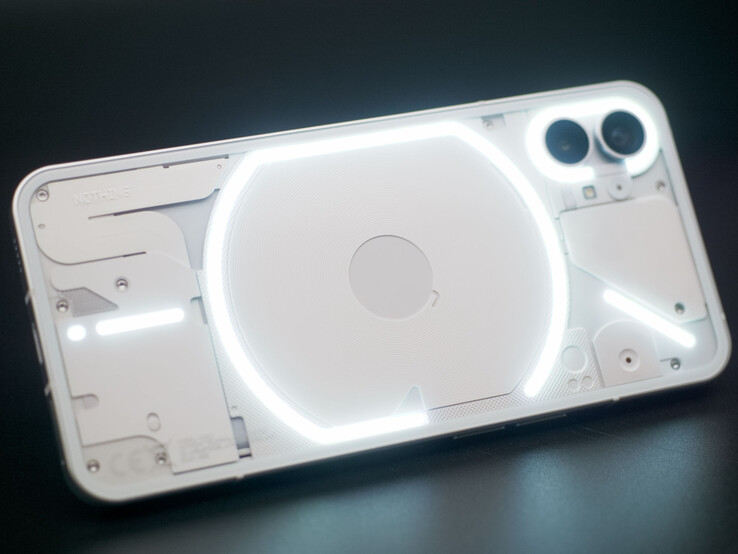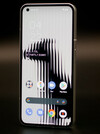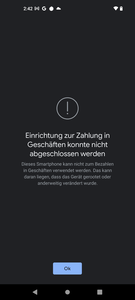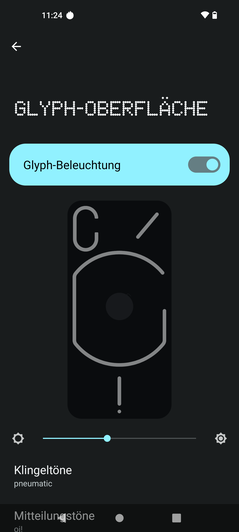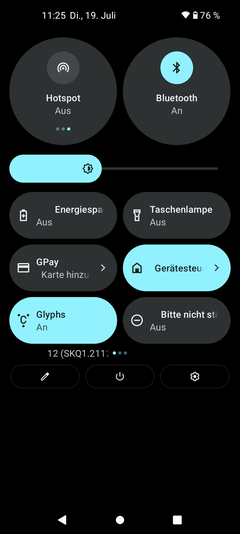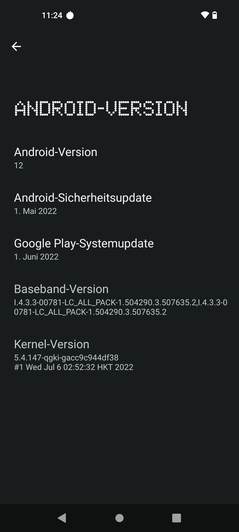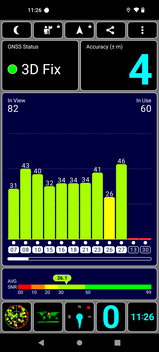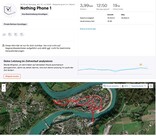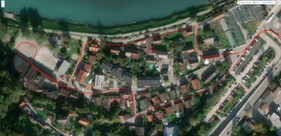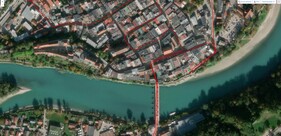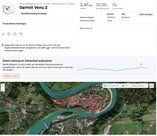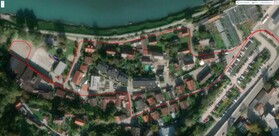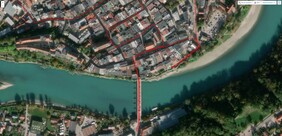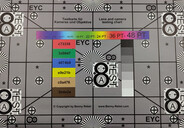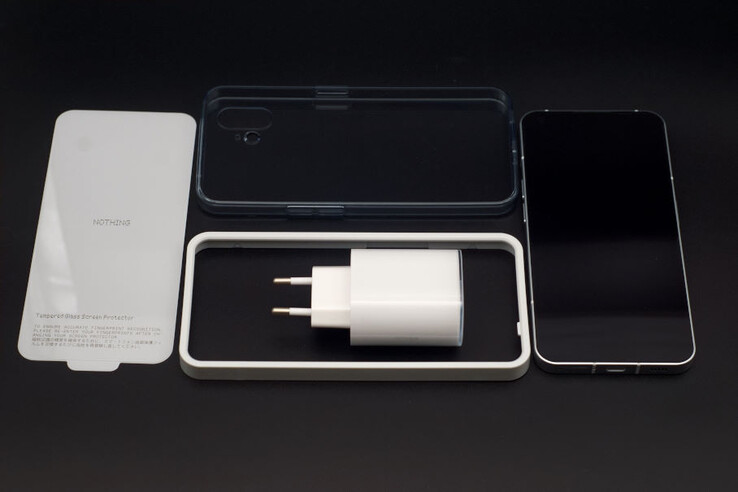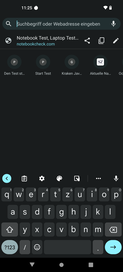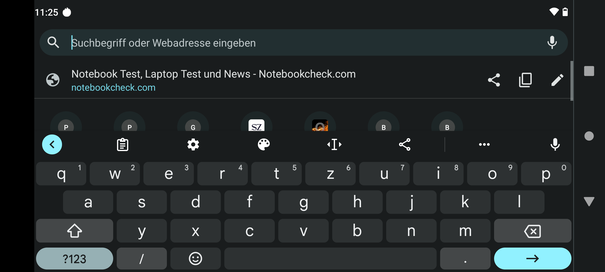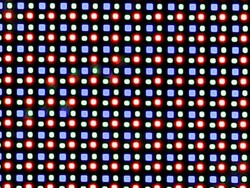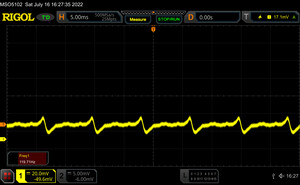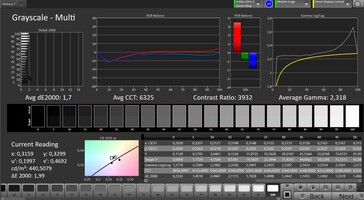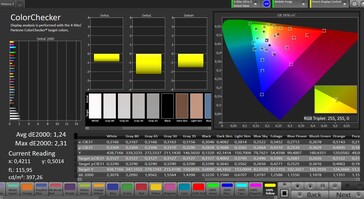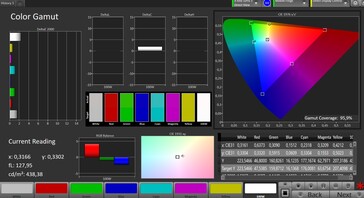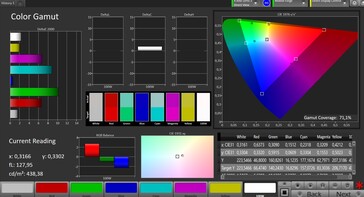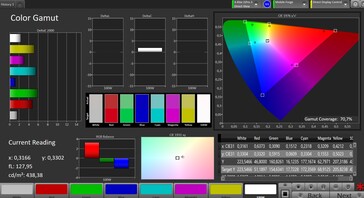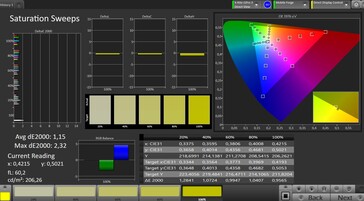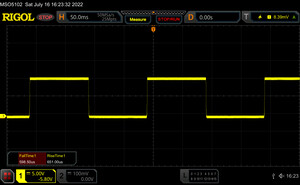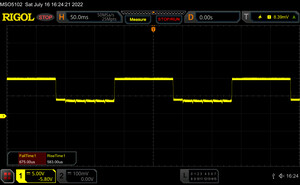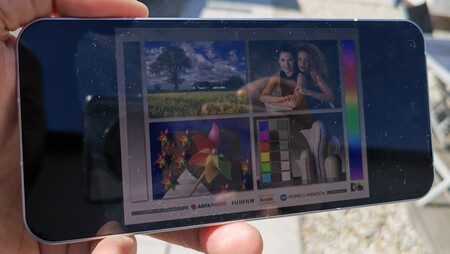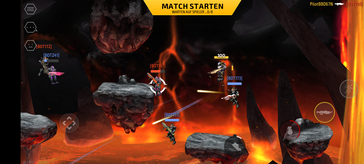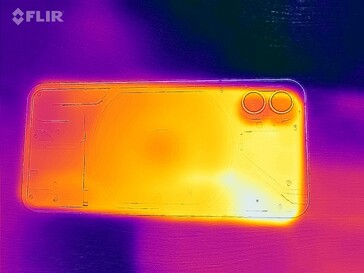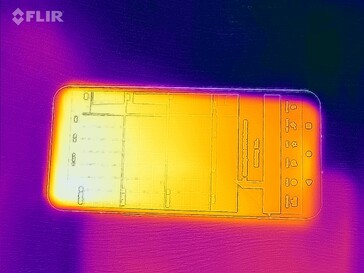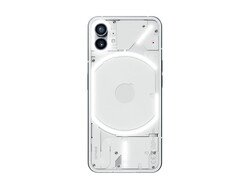Review: Nothing Phone (1) – transparent designer piece at mid-range price
A breath of fresh air is always good for the mobile phone market. OnePlus recognised this and launched the OnePlus One almost 9 years ago – a smartphone that was significantly cheaper and yet almost as good as the flagship phones of its time. Back then, the company's founders chose to do something different by giving the phone a rough sandstone back and a heavily modified Android operating system and, as a result, caused smartphones to change forever.
One of the founders was Carl Pei, who is now aiming to re-enter the phone market with his new company Nothing. This time round, the Nothing Phone (1) might even get OnePlus feeling a little shaken. After taking an extensive look at the Nothing Phone (1) in our hands-on, we now want to re-examine our first impression by taking a closer look at the device and performing measurements and benchmarks. Let's get started.
Comparison of possible competitors
Rating | Date | Model | Weight | Drive | Size | Resolution | Price |
|---|---|---|---|---|---|---|---|
| 85.6 % v7 (old) | 07 / 2022 | Nothing Phone (1) SD 778G+ 5G, Adreno 642L | 193.5 g | 256 GB UFS 3.1 Flash | 6.55" | 2400x1080 | |
| 85.4 % v7 (old) | 06 / 2022 | OnePlus Nord 2T Dimensity 1300, Mali-G77 MP9 | 190 g | 256 GB UFS 3.1 Flash | 6.43" | 2400x1080 | |
| 86.4 % v7 (old) | 07 / 2022 | Motorola Edge 30 SD 778G+ 5G, Adreno 642L | 155 g | 128 GB UFS 3.1 Flash | 6.50" | 2400x1080 | |
| 86.1 % v7 (old) | 04 / 2022 | Apple iPhone SE 2022 A15, A15 GPU 5-Core | 144 g | 64 GB SSD | 4.70" | 1334x750 | |
| 86.6 % v7 (old) | 10 / 2021 | Xiaomi 11T Dimensity 1200, Mali-G77 MP9 | 203 g | 128 GB UFS 3.1 Flash | 6.67" | 2400x1080 |
Case – aluminium frame and LED strips
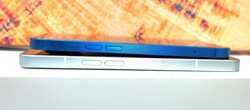
The design is certainly the first thing that catches the eye about the Nothing Phone (1): it is available in a simple white or black with a striking metal frame in silver or black respectively. That said, the actual highlight is the rear of the device. It is covered by a piece of transparent Gorilla Glass 5 that lets users look inside the smartphone.
You might be at least slightly disappointed if you are expecting to see technical details similar to those on the Explorer Edition of various Xiaomi phones. This is because you can mainly just see individual structured elements in slightly different shades of white or black (depending on the phone's colour). Although these elements outline the flow of cables and the shape of components, they also obscure all these things. The only visible metallic bits are part of a speaker grill and a few screws.
The most crucial thing to Nothing is the Glyph Interface, a lighting feature comprising 900 micro LEDs on the device's back and likewise beneath the transparent glass panel. The LEDs can be switched on and off individually or in groups. They can function as a notification light or charge status indicator. Moreover, the manufacturer still has some other plans for the lighting system. Right now, you can assign personalised light patterns to your contacts or use it in silent mode to tell whether you've received an email or a WhatsApp message. When the phone is flipped over, it switches automatically to silent mode and notifies you using light symbols, whose intensity can be adjusted individually.
The front of the phone features a punch-hole camera and an even frame on all sides of the display. The sturdy frame is very reminiscent of the design of the current iPhones and is made of 100% recycled aluminium according to the manufacturer. The Nothing Phone (1) has almost the same exact dimensions as the OnePlus Nord 2T and is only minimally heavier. But it offers a slightly larger diagonal screen size.
Rated at IP53, the Nothing Phone (1) is protected against spraying water and dust, meaning it shouldn't be immersed in water. Whilst the phone is well-built with tight gaps in the body, it creaks noticeably when twisted, which detracts from the impression of quality.
Some users have complained about water or dust accumulating behind the back panel. Currently, it's difficult to find out under what conditions the users are encountering these problems and whether they are isolated cases. Nothing also hasn't provided any statement regarding this.
Specifications – issues with Google Pay
The Nothing Phone (1) comes in three storage and memory configurations, with the smallest only available in black:
- 128 GB storage / 8 GB RAM: 469 Euros (£399)
- 256 GB storage / 8 GB RAM: 499 Euros (£449)
- 256 GB storage / 12 GB RAM: 549 Euros (£499)
The middle option is probably the most interesting one: for 30 Euros (£50) more, you get a generous upgrade in terms of storage. The largest option is only worth it if you are always running very memory-intensive apps and can make full use of the huge amount of RAM. For perspective, you can get the OnePlus Nord 2T with 256 GB storage and 12 GB RAM at a recommended retail price of just 499 Euros (£469).
The USB port is connected internally via USB 2.0, meaning it can transfer data at a maximum speed of 480 Mbit/s. As with most current phones in this price range, the Nothing Phone (1) doesn't have a 3.5 mm audio jack and uses the USB-C port for audio playback. You can plug in a USB-C headphone jack adapter if necessary. The phone supports the up-to-date Bluetooth 5.2 and NFC for wireless communication. The NFC feature also lets you use mobile payment services, but Google Pay can't be set up on the phone right now.
The phone doesn't have a microSD slot, which is an aspect that OnePlus, Carl Pei's former company, has always struggled with. Something we are worried about: the microphone is located right next to the SIM card slot. As a result, when opening the slot, you should be careful not to damage the microphone by accidently inserting the SIM ejector tool into the wrong hole.
Software – Nothing OS is relatively close to stock Android
The phone comes installed with Nothing OS, which turns out to be a relatively stock version of Android 12. The company also promises that the phone will not ship with bloatware – and we can attest to this.
Has Nothing not made any changes to the system at all? No, the design has been modified to use a dot matrix font and there is a separate menu for the Glyph Interface. In addition, the operating system is intended to be an open platform that other manufacturers can easily incorporate in their devices. As an initial step, users can control their Tesla via the operating system. Nothing has also talked about a native NFT gallery app, which is available as a widget and can connect to a corresponding wallet in order to showcase NFTs and track their price.
Some of the ringtones, alarm tones and notification sounds are very high-pitched, technology-inspired and somewhat annoying. There is only a limited selection of ten for each type. If piercing static-like sounds hurt your ears, then you only have a few options left. Incidentally, your furry friends won't be very thrilled by the high-pitched sounds either. But at least you can use your own sounds if you wish.
At the time of our review, the security patches were from May 2022 and therefore no longer very up to date. Nothing promises three major Android updates and four years of security patches, which is now quite average compared with other manufacturers. However, we are still unable to say how often security updates and new features will be rolled out.
Connectivity and GNSS – Wi-Fi is sometimes a little sluggish
The Nothing Phone (1) supports the latest Wi-Fi 6E standard. However, based on measurements taken using our reference router Asus ROG AXE11000, the phone is still unable to take full advantage of this high-speed standard. Whereas the data transmission rate is quite good at 946 Mbit/s, the data reception rate is just average at 598 Mbit/s. The Motorola Edge 30 is substantially more stable in terms of speed.
As expected, the phone is 5G-enabled and supports a wide range of frequencies in both 5G and 4G bands. This means you should also be able to use mobile Internet when abroad in almost any country. We measured the phone's reception strength randomly during our test. We found that the Nothing Phone (1) hardly ever lost full reception (even in buildings) and generally had very good signal strength.
| Networking | |
| iperf3 receive AXE11000 | |
| Apple iPhone SE 2022 | |
| Average of class Smartphone (52 - 1857, n=181, last 2 years) | |
| OnePlus Nord 2T | |
| iperf3 transmit AXE11000 | |
| Apple iPhone SE 2022 | |
| OnePlus Nord 2T | |
| Average of class Smartphone (49.8 - 1806, n=181, last 2 years) | |
| iperf3 transmit AXE11000 6GHz | |
| Average of class Smartphone (508 - 1945, n=85, last 2 years) | |
| Motorola Edge 30 | |
| Nothing Phone (1) | |
| iperf3 receive AXE11000 6GHz | |
| Average of class Smartphone (451 - 1864, n=85, last 2 years) | |
| Motorola Edge 30 | |
| Nothing Phone (1) | |
| iperf3 transmit AX12 | |
| Xiaomi 11T | |
| iperf3 receive AX12 | |
| Xiaomi 11T | |
The phone was able to quickly identify our location outdoors. But it took some time for the accuracy to increase to a decent four metres (~13 feet). The Nothing Phone (1) can communicate with all conventional satellite networks to determine location. However, the SBAS network, which is designed to improve position accuracy, was not accessed during our review.
In order to assess the phone's location accuracy in real-life situations, we got on our bicycle and brought along a Garmin Venu 2 for comparison. The result: the Nothing Phone (1) was sometimes slightly off the route taken but otherwise didn't make any major mistakes. The phone can be used for day-to-day navigation without any issues.
Call functions and voice quality – Nothing leaves something to be desired
The Nothing Phone (1) uses Google apps for phone calls and contacts, meaning users of other phones with stock android should be able to find their way around quickly. The apps are logically structured and easily accessible even for newbies.
We are not fully impressed by the phone's voice quality: the internal ear speaker sounds very trebly and buzzes audibly at maximum volume. The microphone is able to pick up our voice quite well. The person on the other end of the line sounds better on the phone's speaker. However, the hands-free mic has problems suppressing ambient noise.
Cameras – two lenses should be enough
Nothing equipped its first smartphone with only two cameras: a main camera and a wide-angle camera. Both can support resolutions up to 50 megapixels. However, they will usually only take photos at a resolution of 12.5 megapixels. This is because the sensors bin four pixels into a larger pixel to capture more light. The full resolution can only be used in a special software mode.
The main camera uses a Sony IMX766 sensor with optical image stabilisation. Although the camera can't keep up with those on high-end smartphones in terms of details and sharpness, it delivers photo quality that is standard for its class and absolutely fit for everyday use. Its weaknesses become even more apparent in low-light and high-contrast situations. Even though the subject is still recognisable here, the details are blurry and darker areas have hardly been brightened.
We are slightly more impressed by the wide-angle camera. Whilst you probably still shouldn't zoom in too much on shots taken using the wide-angle camera, details that are far away can still be made out to an extent not achieved by other wide-angle cameras on smartphones.
Nothing has also come up with a few ways to use the Glyph Interface with the camera. The LEDs on the rear can be used like a ring light when recording videos and produce a light that is mellow but not particularly warm. The Glyph Interface can also be used to indicate the time left when the camera timer is active. What's more, you can enable a red LED when recording videos – reminiscent of professional video cameras.
Speaking of videos, the phone can record at up to 4K and 30 fps. It is also capable of taking 1080p videos at 60 fps. We like the image quality, even in lower lighting conditions. Exposure adjustment and autofocus react swiftly and almost inconspicuously.
The haptic feedback when zooming is very nicely designed. The phone is able to properly simulate the sound and feel of a mechanical zoom ring. However, there is no hybrid zoom between the wide-angle and main cameras, meaning you will need to settle on one of the cameras before you start recording a video.
Image comparison
Choose a scene and navigate within the first image. One click changes the position on touchscreens. One click on the zoomed-in image opens the original in a new window. The first image shows the scaled photograph of the test device.
Main camera FlowerMain camera EnvironmentMain camera Low LightWide-angle cameraIn our laboratory tests, our test pattern was photographed under studio lighting. The main camera produces images with good contrast and little artefacts on large coloured areas. But the images are significantly softer towards the edges.
The camera struggles noticeably in low light, but at least manages to keep the subject identifiable.
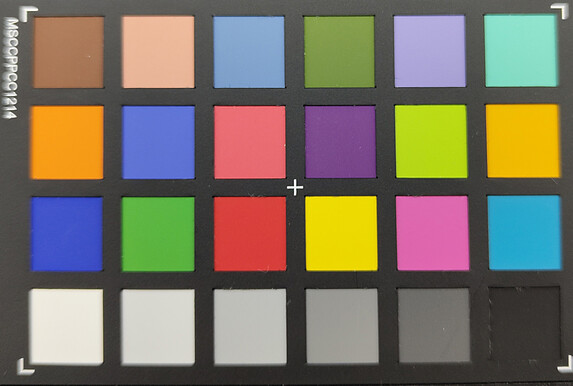
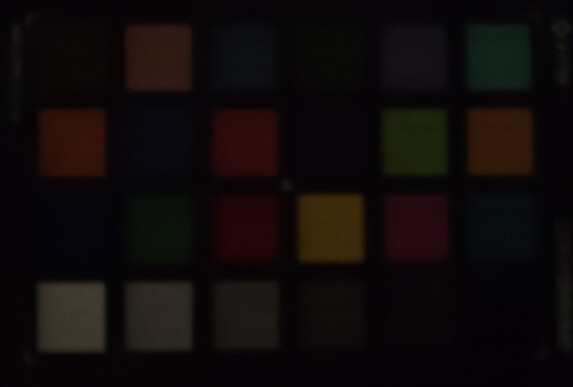
Accessories and warranty – charger not included
Nothing didn't include a charger with its smartphone. The only other items in the box are a USB-C cable, an especially designed SIM ejector tool and some paperwork. A screen protector has also been pre-applied.
Nothing sells a 45-watt charger for 35 Euros (£35). This seems to be an odd choice considering the smartphone only has a maximum charging speed of 33 watts. A new screen protector can be had for 19 Euros (£19), while a specifically designed case costs 25 Euros (£25).
The manufacturer offers a 24-month warranty when the phone is purchased in the EU.
Input devices and operation – fingerprint sensor sits low on the phone
The 120 Hz touchscreen on the Nothing Phone (1) is very precise to use and responds to quick inputs without perceivable delay.
The fingerprint reader is located underneath the screen and quite close to the lower edge. This meant we had to change our grip a little when holding the phone in our hand. However, the sensor works very reliably and unlocks the phone from standby mode rather promptly.
The phone can also be unlocked using 2D facial recognition, but this option only works in good ambient light and is less secure than a hardware solution with infrared sensor.
Display – slim bezel and 120 Hz support
The OLED panel in the Nothing Phone (1) is made by Visionox. The company has managed to keep the bezel on all sides of the screen equally slim, resulting in a stylish design. At the same time, the panel is on par with the competition with an extended Full HD resolution and an average brightness of 625 cd/m² in our test. Only the Xiaomi 11T can produce significantly higher brightness levels when its ambient light sensor is exposed to light.
The screen on the Nothing Phone (1) can switch between 60 Hz and 120 Hz. During our review, however, we noticed that the phone wouldn't leave the 120 Hz mode once it is activated, despite the fact that the system should be able to switch dynamically between 60 Hz and 120 Hz. A lower refresh rate would help save battery when you are reading text, for example.
Another thing that we like is the OLED panel's colour reproduction, which is extremely accurate in "Standard" mode. In this mode, colours are indistinguishable from the target value of the colour space with the naked eye. Shades of grey also don't have any colour tint.
Some users on the Internet have reported that their screen has a green tint or defective pixels. The display on our test unit is completely fine.
| |||||||||||||||||||||||||
Brightness Distribution: 98 %
Center on Battery: 620 cd/m²
Contrast: ∞:1 (Black: 0 cd/m²)
ΔE ColorChecker Calman: 1.24 | ∀{0.5-29.43 Ø4.82}
ΔE Greyscale Calman: 1.7 | ∀{0.09-98 Ø5.1}
95.9% sRGB (Calman 2D)
Gamma: 2.318
CCT: 6325 K
| Nothing Phone (1) OLED, 2400x1080, 6.6" | OnePlus Nord 2T AMOLED, 2400x1080, 6.4" | Motorola Edge 30 AMOLED, 2400x1080, 6.5" | Apple iPhone SE 2022 IPS, 1334x750, 4.7" | Xiaomi 11T AMOLED, 2400x1080, 6.7" | |
|---|---|---|---|---|---|
| Screen | -74% | -20% | -19% | -13% | |
| Brightness middle | 620 | 561 -10% | 632 2% | 662 7% | 781 26% |
| Brightness | 625 | 573 -8% | 630 1% | 647 4% | 782 25% |
| Brightness Distribution | 98 | 96 -2% | 92 -6% | 92 -6% | 94 -4% |
| Black Level * | 0.4 | ||||
| Colorchecker dE 2000 * | 1.24 | 2.67 -115% | 1.46 -18% | 1.44 -16% | 2 -61% |
| Colorchecker dE 2000 max. * | 2.31 | 6.15 -166% | 3.32 -44% | 4.74 -105% | 2.9 -26% |
| Greyscale dE 2000 * | 1.7 | 4.1 -141% | 2.6 -53% | 1.7 -0% | 2.3 -35% |
| Gamma | 2.318 95% | 2.245 98% | 2.209 100% | 2.179 101% | 2.28 96% |
| CCT | 6325 103% | 7104 91% | 6755 96% | 6746 96% | 6852 95% |
| Contrast | 1655 |
* ... smaller is better
Screen Flickering / PWM (Pulse-Width Modulation)
| Screen flickering / PWM detected | 119.7 Hz | ||
The display backlight flickers at 119.7 Hz (worst case, e.g., utilizing PWM) . The frequency of 119.7 Hz is very low, so the flickering may cause eyestrain and headaches after extended use. In comparison: 53 % of all tested devices do not use PWM to dim the display. If PWM was detected, an average of 8276 (minimum: 5 - maximum: 343500) Hz was measured. | |||
Series of measurements at a fixed zoom level and various brightness settings
We are positively surprised by the refresh rate, which stayed more or less even at minimal brightness at a constant 120 Hz, in our measurements made using an oscilloscope. Consequently, it is unlikely for people who are sensitive to get headaches from the phone's OLED panel, as its frequency hardly fluctuates.
With response times just slightly above 1 millisecond, the display should also be able to satisfy gamers.
Display Response Times
| ↔ Response Time Black to White | ||
|---|---|---|
| 1.3 ms ... rise ↗ and fall ↘ combined | ↗ 6 ms rise | |
| ↘ 7 ms fall | ||
| The screen shows very fast response rates in our tests and should be very well suited for fast-paced gaming. In comparison, all tested devices range from 0.1 (minimum) to 240 (maximum) ms. » 5 % of all devices are better. This means that the measured response time is better than the average of all tested devices (20.4 ms). | ||
| ↔ Response Time 50% Grey to 80% Grey | ||
| 1.3 ms ... rise ↗ and fall ↘ combined | ↗ 7 ms rise | |
| ↘ 6 ms fall | ||
| The screen shows very fast response rates in our tests and should be very well suited for fast-paced gaming. In comparison, all tested devices range from 0.165 (minimum) to 636 (maximum) ms. » 5 % of all devices are better. This means that the measured response time is better than the average of all tested devices (31.9 ms). | ||
Performance – good mid-range capabilities
We've already seen the Qualcomm Snapdragon 778G+ being used in the Motorola Edge 30. In terms of performance, the SoC is in the upper mid-range and expectedly can't hold a candle to the Apple A15 Bionic in the iPhone SE 2022. The Mediatek SoCs in the OnePlus Nord 2T or Xiaomi 11T are at a very similar level performance-wise. Nevertheless, they are significantly better at handling AI-related computations, as shown by AImark.
According to Nothing, the SoC has been specifically customised for the Nothing Phone (1). However, this is only in reference to wireless charging – a feature that, for instance, is not present on the Motorola Edge 30 even though it has the same chipset. Some have criticised Nothing for not using a high-end chip to challenge flagship phones. But the phone's computing power is perfectly adequate for everyday use in most situations and it offers the same level of performance as similarly priced smartphones.
| CrossMark - Overall | |
| Apple iPhone SE 2022 | |
| Average of class Smartphone (187 - 2674, n=140, last 2 years) | |
| Nothing Phone (1) | |
| Average Qualcomm Snapdragon 778G+ 5G (730 - 760, n=3) | |
| Motorola Edge 30 | |
| Xiaomi 11T | |
| AImark - Score v2.x | |
| Apple iPhone SE 2022 | |
| Xiaomi 11T | |
| OnePlus Nord 2T | |
| Average Qualcomm Snapdragon 778G+ 5G (5777 - 139804, n=3) | |
| Nothing Phone (1) | |
| Motorola Edge 30 | |
The Adreno 624L in the Nothing Phone (1) delivers enough graphics performance, even for more demanding applications. Nonetheless, it struggles to keep up with other devices in our comparison. For example, the OnePlus Nord 2T and Xiaomi 11T have substantially more graphics horsepower.
| GFXBench (DX / GLBenchmark) 2.7 | |
| T-Rex Onscreen | |
| Xiaomi 11T | |
| Nothing Phone (1) | |
| Motorola Edge 30 | |
| Apple iPhone SE 2022 | |
| OnePlus Nord 2T | |
| 1920x1080 T-Rex Offscreen | |
| Apple iPhone SE 2022 | |
| OnePlus Nord 2T | |
| Xiaomi 11T | |
| Motorola Edge 30 | |
| Nothing Phone (1) | |
| GFXBench 3.0 | |
| on screen Manhattan Onscreen OGL | |
| Xiaomi 11T | |
| Motorola Edge 30 | |
| Nothing Phone (1) | |
| Apple iPhone SE 2022 | |
| OnePlus Nord 2T | |
| 1920x1080 1080p Manhattan Offscreen | |
| Apple iPhone SE 2022 | |
| OnePlus Nord 2T | |
| Xiaomi 11T | |
| Motorola Edge 30 | |
| Nothing Phone (1) | |
| GFXBench 3.1 | |
| on screen Manhattan ES 3.1 Onscreen | |
| Xiaomi 11T | |
| Motorola Edge 30 | |
| Apple iPhone SE 2022 | |
| Nothing Phone (1) | |
| OnePlus Nord 2T | |
| 1920x1080 Manhattan ES 3.1 Offscreen | |
| Xiaomi 11T | |
| OnePlus Nord 2T | |
| Nothing Phone (1) | |
| Motorola Edge 30 | |
| Apple iPhone SE 2022 | |
| GFXBench | |
| on screen Car Chase Onscreen | |
| Apple iPhone SE 2022 | |
| Xiaomi 11T | |
| OnePlus Nord 2T | |
| Motorola Edge 30 | |
| Nothing Phone (1) | |
| 1920x1080 Car Chase Offscreen | |
| Apple iPhone SE 2022 | |
| OnePlus Nord 2T | |
| Xiaomi 11T | |
| Motorola Edge 30 | |
| Nothing Phone (1) | |
| on screen Aztec Ruins High Tier Onscreen | |
| Apple iPhone SE 2022 | |
| Xiaomi 11T | |
| OnePlus Nord 2T | |
| Motorola Edge 30 | |
| Nothing Phone (1) | |
| 2560x1440 Aztec Ruins High Tier Offscreen | |
| Apple iPhone SE 2022 | |
| Xiaomi 11T | |
| Motorola Edge 30 | |
| Nothing Phone (1) | |
| OnePlus Nord 2T | |
| on screen Aztec Ruins Normal Tier Onscreen | |
| Apple iPhone SE 2022 | |
| Xiaomi 11T | |
| OnePlus Nord 2T | |
| Motorola Edge 30 | |
| Nothing Phone (1) | |
| 1920x1080 Aztec Ruins Normal Tier Offscreen | |
| Apple iPhone SE 2022 | |
| OnePlus Nord 2T | |
| Xiaomi 11T | |
| Nothing Phone (1) | |
| Motorola Edge 30 | |
In the browser benchmarks, the Nothing Phone (1) consistently lagged behind the competition. Having said that, it does well in everyday use, loads websites relatively quickly and is sometimes able to get images ready while the page is being scrolled.
| Jetstream 2 - 2.0 Total Score | |
| Apple iPhone SE 2022 (Chrome 99) | |
| Average of class Smartphone (13.8 - 387, n=154, last 2 years) | |
| Motorola Edge 30 (Chrome 102.0.5005.125) | |
| Average Qualcomm Snapdragon 778G+ 5G (73.7 - 100.4, n=3) | |
| Nothing Phone (1) (Chrome 103) | |
| OnePlus Nord 2T (Chrome 102) | |
| Xiaomi 11T (Chrome 94.0.4606.85) | |
| Speedometer 2.0 - Result | |
| Apple iPhone SE 2022 (Chome 99) | |
| Average of class Smartphone (15.2 - 585, n=137, last 2 years) | |
| Motorola Edge 30 (Chrome 102.0.5005.125) | |
| Average Qualcomm Snapdragon 778G+ 5G (53.7 - 66.5, n=3) | |
| OnePlus Nord 2T (Chome 102) | |
| Xiaomi 11T (Chrome 94.0.4606.85) | |
| Nothing Phone (1) (Chome 103) | |
| WebXPRT 3 - Overall | |
| Apple iPhone SE 2022 (Chrome 99) | |
| Average of class Smartphone (38 - 347, n=55, last 2 years) | |
| Motorola Edge 30 (Chrome 102.0.5005.125) | |
| Average Qualcomm Snapdragon 778G+ 5G (102 - 127, n=3) | |
| Nothing Phone (1) (Chrome 103) | |
| Xiaomi 11T (Chrome 94.0.4606.85) | |
| OnePlus Nord 2T (Chrome 102) | |
| Octane V2 - Total Score | |
| Apple iPhone SE 2022 (Chrome 99) | |
| Average of class Smartphone (2228 - 100368, n=205, last 2 years) | |
| OnePlus Nord 2T (Chrome 102) | |
| Motorola Edge 30 (Chrome 102.0.5005.125) | |
| Xiaomi 11T (Chrome 94.0.4606.85) | |
| Average Qualcomm Snapdragon 778G+ 5G (24488 - 32794, n=3) | |
| Nothing Phone (1) (Chrome 103) | |
| Mozilla Kraken 1.1 - Total | |
| Nothing Phone (1) (Chrome 103) | |
| Average Qualcomm Snapdragon 778G+ 5G (1236 - 1796, n=3) | |
| Xiaomi 11T (Chrome 94.0.4606.85) | |
| OnePlus Nord 2T (Chrome 102) | |
| Motorola Edge 30 (Chrome 102.0.5005.125) | |
| Average of class Smartphone (277 - 28190, n=158, last 2 years) | |
| Apple iPhone SE 2022 (Chrome 99) | |
* ... smaller is better
The snappy UFS 3.1 storage allows the Nothing Phone (1) to achieve fast loading times when launching apps and to copy files quickly. In particular, write operations are performed at very high speeds.
| Nothing Phone (1) | OnePlus Nord 2T | Motorola Edge 30 | Xiaomi 11T | Average 256 GB UFS 3.1 Flash | Average of class Smartphone | |
|---|---|---|---|---|---|---|
| AndroBench 3-5 | 6% | -7% | -26% | 13% | 35% | |
| Sequential Read 256KB | 1638 | 1891.3 15% | 1514.62 -8% | 1790 9% | 1736 ? 6% | 2198 ? 34% |
| Sequential Write 256KB | 1351.9 | 1300.6 -4% | 965.35 -29% | 942 -30% | 1176 ? -13% | 1800 ? 33% |
| Random Read 4KB | 240.6 | 235.8 -2% | 241.72 0% | 139.3 -42% | 286 ? 19% | 295 ? 23% |
| Random Write 4KB | 228.2 | 262.2 15% | 249.14 9% | 133.3 -42% | 314 ? 38% | 338 ? 48% |
Gaming – capable of 120 fps
In our first gaming test with Armajet, it was straight away apparent that the phone is almost able to take full advantage of the screen's 120 Hz refresh rate and run the game at close to 120 fps, which enables faster reactions.
In PUBG Mobile, a more demanding 3D shooter, the phone still managed to hit around 40 fps at high settings and roughly 60 fps at low settings. All of these are good results, meaning that we can absolutely recommend the Nothing Phone (1) for gaming use, as long as you don't need to play games at the highest settings at all cost. We used GameBench to measure frame rate.
In terms of controls, the smartphone doesn't exhibit any weaknesses: both the touchscreen and motion sensor react to inputs accurately and very swiftly.
Emissions – gets very warm but doesn't throttle
Temperature
Reaching up to 46 °C (114.8 °F), the Nothing Phone (1) can get very warm after running at full load for a while. Although the heat is only clearly noticeable on the upper part of the phone, it may at times become uncomfortable to use, especially when ambient temperatures are high in summer. In normal day-to-day use, however, you won't be able to feel the heat as much because the phone manages to stay nice and cool.
The phone's performance also doesn't seem to be affected by the heat generated. The system didn't slow down appreciably even after several loops of 3DMark Stress Tests.
(-) The maximum temperature on the upper side is 46 °C / 115 F, compared to the average of 35.2 °C / 95 F, ranging from 21.9 to 247 °C for the class Smartphone.
(±) The bottom heats up to a maximum of 41.7 °C / 107 F, compared to the average of 33.9 °C / 93 F
(+) In idle usage, the average temperature for the upper side is 25.6 °C / 78 F, compared to the device average of 32.9 °C / 91 F.
3DMark Wild Life Stress Test
| 3DMark | |
| Wild Life Stress Test Stability | |
| Nothing Phone (1) | |
| Motorola Edge 30 | |
| Xiaomi 11T | |
| Apple iPhone SE 2022 | |
| OnePlus Nord 2T | |
| Wild Life Extreme Stress Test | |
| Motorola Edge 30 | |
| Nothing Phone (1) | |
| Xiaomi 11T | |
| OnePlus Nord 2T | |
| Apple iPhone SE 2022 | |
Speakers
The Nothing Phone (1) uses the ear speaker as a second speaker to create a stereo effect. But because it is much weaker than the main speaker, the effect is not entirely pronounced. The sound produced is balanced and quite high-quality. At maximum volume, some high frequencies are a little too emphasised for our liking, but there isn't any audible buzzing or rattling at all.
The phone can connect to external audio devices via USB-C or Bluetooth 5.2 and supports aptX codecs (including aptX Adaptive), LDAC and LHDC. In our tests, both connection options provided good sound quality.
Nothing Phone (1) audio analysis
(+) | speakers can play relatively loud (84.3 dB)
Bass 100 - 315 Hz
(-) | nearly no bass - on average 25.3% lower than median
(±) | linearity of bass is average (12.2% delta to prev. frequency)
Mids 400 - 2000 Hz
(±) | higher mids - on average 6.6% higher than median
(+) | mids are linear (5.5% delta to prev. frequency)
Highs 2 - 16 kHz
(+) | balanced highs - only 4.7% away from median
(+) | highs are linear (6.1% delta to prev. frequency)
Overall 100 - 16.000 Hz
(±) | linearity of overall sound is average (22.8% difference to median)
Compared to same class
» 49% of all tested devices in this class were better, 6% similar, 45% worse
» The best had a delta of 12%, average was 35%, worst was 134%
Compared to all devices tested
» 66% of all tested devices were better, 6% similar, 28% worse
» The best had a delta of 4%, average was 24%, worst was 134%
Xiaomi 11T audio analysis
(+) | speakers can play relatively loud (88.6 dB)
Bass 100 - 315 Hz
(-) | nearly no bass - on average 24.1% lower than median
(±) | linearity of bass is average (9.6% delta to prev. frequency)
Mids 400 - 2000 Hz
(±) | reduced mids - on average 5.1% lower than median
(+) | mids are linear (4.6% delta to prev. frequency)
Highs 2 - 16 kHz
(+) | balanced highs - only 1.9% away from median
(+) | highs are linear (4% delta to prev. frequency)
Overall 100 - 16.000 Hz
(±) | linearity of overall sound is average (15.9% difference to median)
Compared to same class
» 4% of all tested devices in this class were better, 4% similar, 92% worse
» The best had a delta of 12%, average was 35%, worst was 134%
Compared to all devices tested
» 23% of all tested devices were better, 5% similar, 72% worse
» The best had a delta of 4%, average was 24%, worst was 134%
Battery life – wireless charging supported
Power consumption
In terms of energy efficiency, the Nothing Phone (1) is on par with other phones in this range. It doesn't really stand out in any particular aspect. Likewise, the exhaustive usage tests conducted using Geekbench and GFXBench didn't yield anything noteworthy.
The Nothing Phone (1) can charge at up to 33 watts when connected via a cable. This can be done using any charger with USB Power Delivery 3.0 and support for Quick Charge 4.0. According to the company, it is possible to fully charge the phone within 70 minutes – something we can confirm after performing our tests. This puts the Nothing Phone (1) significantly behind the OnePlus Nord 2T and Xiaomi 11T when it comes to charging speed. In some cases, these two phones can charge two and a half or even four times faster than the Nothing Phone (1).
One distinctive feature of the phone is its compatibility with the Qi wireless-charging standard. The iPhone SE 2022 is the only other device in our comparison that has this feature. At a maximum charging speed of 15 watts, it takes around two hours to fully charge the phone wirelessly. The Nothing Phone (1) can also be used to wirelessly charge other devices at speeds of up to 5 watts.
| Off / Standby | |
| Idle | |
| Load |
|
Key:
min: | |
| Nothing Phone (1) 4500 mAh | OnePlus Nord 2T 4500 mAh | Motorola Edge 30 4020 mAh | Apple iPhone SE 2022 2018 mAh | Xiaomi 11T 5000 mAh | Average Qualcomm Snapdragon 778G+ 5G | Average of class Smartphone | |
|---|---|---|---|---|---|---|---|
| Power Consumption | 0% | 6% | -8% | -14% | -8% | -26% | |
| Idle Minimum * | 1 | 0.9 10% | 0.9 10% | 0.6 40% | 0.78 22% | 1.067 ? -7% | 0.865 ? 13% |
| Idle Average * | 1.2 | 1.3 -8% | 1.2 -0% | 0.9 25% | 1.86 -55% | 1.333 ? -11% | 1.428 ? -19% |
| Idle Maximum * | 1.5 | 1.7 -13% | 1.5 -0% | 1.5 -0% | 1.88 -25% | 1.7 ? -13% | 1.592 ? -6% |
| Load Average * | 4.2 | 4 5% | 3.6 14% | 6.5 -55% | 3.98 5% | 4.37 ? -4% | 7.2 ? -71% |
| Load Maximum * | 7.4 | 6.8 8% | 7.1 4% | 11 -49% | 8.78 -19% | 7.8 ? -5% | 10.8 ? -46% |
* ... smaller is better
Power consumption: Geekbench (150 cd/m²)
Power consumption: GFXBench (150 cd/m²)
Battery life
The 4,500 mAh battery is large enough to keep the Nothing Phone (1) running for an impressive 15 hours and 26 minutes in our Wi-Fi test.
Whilst OnePlus and Xiaomi smartphones have slightly longer battery life, the first phone from Nothing should be able to last several days without charging, depending on usage.
| Nothing Phone (1) 4500 mAh | OnePlus Nord 2T 4500 mAh | Motorola Edge 30 4020 mAh | Apple iPhone SE 2022 2018 mAh | Xiaomi 11T 5000 mAh | |
|---|---|---|---|---|---|
| Battery Runtime | 7% | -11% | -17% | 13% | |
| Reader / Idle | 1813 | 1936 7% | 1604 -12% | 2049 13% | 2244 24% |
| H.264 | 1059 | 1158 9% | 1002 -5% | 797 -25% | 1450 37% |
| WiFi v1.3 | 926 | 949 2% | 638 -31% | 769 -17% | 813 -12% |
| Load | 259 | 279 8% | 268 3% | 164 -37% | 267 3% |
Pros
Cons
Verdict – definitely something special
On the one hand, the Nothing Phone (1) is definitely something special due to its distinctive look and features such as wireless charging and an aluminium frame, which you seldom see in this price range. On the other hand, it is not as revolutionary as the OnePlus One once was, a phone that shifted entire price brackets on the smartphone market and introduced software features that were unique at that time.
For its first smartphone, Nothing mostly sticks to conventions common in this price range, despite the fact that the Glyph Interface is innovative and can be used in variety of ways, for instance, as a charge status indicator or camera light.
In terms of software, Nothing still has room for improvement in many areas: besides some odd translations and features available only in English (such as the Tesla Link), we would like to see more ringtones and alarm tones that are less jarring. There is also still potential for optimisation in the speed of the Wi-Fi module (which at least supports Wi-Fi 6E), the screen's refresh rate, Google Pay support and the performance. These are all improvements that could perhaps be delivered through a software update.
Long battery life, an AMOLED display with permanent DC dimming mode, solid speakers and fairly accurate location tracking are all strong points of this phone.
On its own, the Nothing Phone (1) is a great device for its price. The phone is enjoyable to use and is going to make users stand out in their daily life. But it is not quite a revolution.
For faster charging and more performance, you can take a look at the OnePlus Nord 2T or Xiaomi 11T. The iPhone SE 2022 likewise features wireless charging and high-end performance, but it has a small screen and an outdated design.
Price and availability
The Phone (1) is available from Nothing's online shop at prices between 469 Euros (£399) and 549 Euros (£499). The company says that it also accepts cryptocurrencies as a payment method. Alternatively, you can pre-order every variant of the phone at amazon.co.uk. The phone is scheduled to start shipping in late July or early August.
Nothing Phone (1)
- 08/30/2022 v7 (old)
Florian Schmitt





